John Henry Patterson
The Biography of the Founder of NCR

Part 1 1884-1884
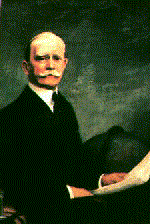
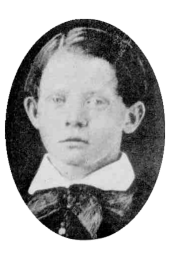
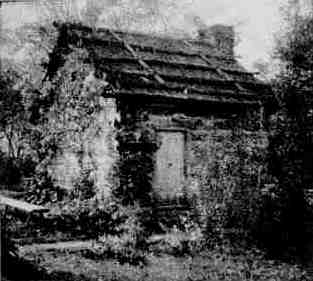
John H. Patterson sprang from sturdy Revolutionary stock. His grandfather, Colonel Robert Patterson, who fought under George Washington, founded Lexington, Kentucky, and was also one of the founders of Cincinnati. In 1788, Robert Patterson, then a lieutenant in the service of the United States government, was ordered to strengthen the frontier of the colonies along the Kentucky River. He, with twenty-five other men, of whom he was the leader, erected the first blockhouse at Lexington.
The home to which Colonel Patterson brought his family in 1804 was a substantial log house which stood just west of the junction of Main Street and Spring House Road
He ultimately settled on what came to be known as Rubicon Farm just south of Dayton. He acquired a large tract of land and erected a log cabin as his home. In March, 1780, he was married to Elizabeth Lindsay, of eastern Pennsylvania. Immediately after the wedding the bride and groom, accompanied by some kinsmen, started on the long journey for their frontier home. In 1799, Colonel Patterson set out to visit two of his brothers who had recently settled near Dayton, Ohio, and while here he was urged to join them in the Miami Valley. He was very much pleased with the climate and fertile soil of Ohio. A few years later he bought a large tract of land south of Dayton.
There were ten children, of whom Jefferson Patterson, the father of John H. Patterson, was the youngest. Jefferson was born in 1801, and lived the life of a typical frontier boy. He helped his father and brothers till the soil and operate the mills on the farm. In February, 1833, he was united in marriage to Julia Johnston, at the bride's home in Piqua, Ohio. Julia Johnston Patterson was the daughter of Colonel John Johnston, Indian agent of the United States government. The Indians respected him, knowing that he always was watchful of their interests. He was absolutely fair and just in his transactions and insisted on white men and Indians always dealing justly with each other. The result was a fairly peaceful settlement of the district over which he presided for many years.
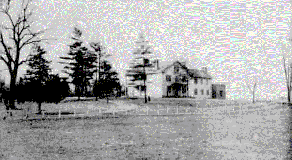
The Patterson Homestead on Rubicon Farm
On December 13, 1844, John H. Patterson was born at the Patterson homestead on Rubicon Farm. Here John spent his boy-hood serving a hardy apprenticeship in work. With the other children, he helped his father and mother carry out the many duties necessary to the successful conduct of the home. Each child had a definite task assigned and it had to be done. Mr. Patterson's mother, in telling of the duties of her son John on the farm, said:
"He used to be called at four o'clock in the spring, summer, and fall. He had to make his grandfather's fire, carry up enough wood to last Colonel Robert Patterson all day, split kindling and get it ready for the night. After breakfast he would turn the calves out, put up his dinner, and go to school. In the evening he drove up the calves, fed and bedded them, carried up wood to fill the boxes, and after supper studied lessons."
As he grew older he took on more duties of the farm. He worked with the men in the fields, ploughing, planting, and harvesting the crops. This experience, he often said, helped him to make the N. C. R. the greatest industry of its kind in the world.
In speaking of his mother, he often said:
"My mother gave me me inspiration to work hard, be successful, and make it possible to see the many things I have seen in all parts of the world."
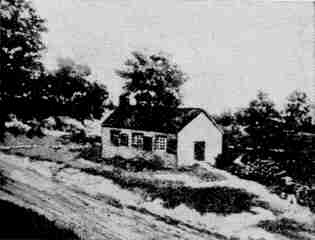
The School House
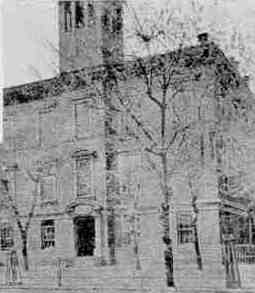
Central High School in Dayton
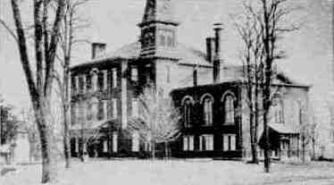
Like many other Americans who rose to distinction.he obtained his early education in a little red schoolhouse.
The one that John attended stood at the corner of Far Hills Avenue and Brown Street. The photograph on the left was taken,age 12, when he was attending this school.
John H. Patterson spent his youth on the family farm just south of Dayton, Ohio (population 10,000) selling his father's farm products. Sometimes the charges were unrecorded and Patterson later recalled, "I was often awakened at night by my father asking me if I had charged a certain person with the things he had taken home". Or,"I would be eating my dinner and some person would say 'Did you charge that sugar to Sonders?' I had to say, 'No, I did not'".
After graduating from Central High School in Dayton in 1862. That fall he entered Miami University at Oxford, where he remained two years. Three of his brothers being in the Civil War service and his father in the Ohio legislature, it was necessary for him to interrupt his studies at the university to help his mother on the farm. President Lincoln issued a call for volunteers to serve in the Union army for one hundred days, and John H. Patterson answered the call of his country, enlisting in the 131st 0. V. I. He served with his company until at the end of his enlistment. When he was honorably discharged on August 25, 1864, he returned to Miami University.
Miami University, Oxford, Ohio
In the fall of 1865, he entered Dartmouth College, and in 1867 was graduated with the A. B. degree. During his college vacation he helped to pay his expenses by teaching school.
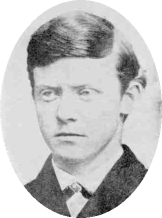
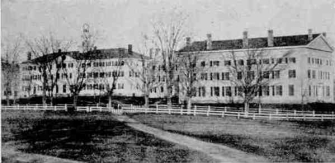
Dartmouth College, Exeter, N.H.
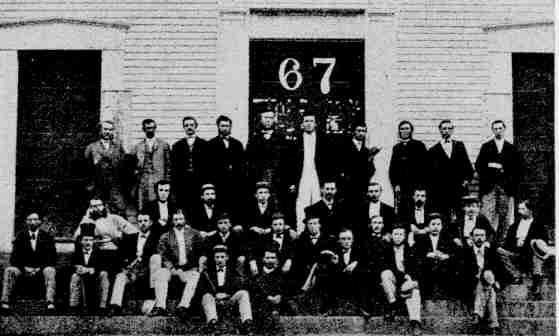
The Dartmouth Graduation Class of 1867.
John H. Patterson is on the middle row, second right.
Returning to Dayton after his graduation he sought a position in the city. He was not successful. So it was necessary for him to go back to the farm. He always felt keenly that his college education did not fit him for a business career. After working on the farm two years he decided that he was wasting his time at work which could be hired done for seventy-five cents a day. He then went into town to look for a position, After a brief experience as school teacher he secured the job of toll collector on the Miami and Erie canal.
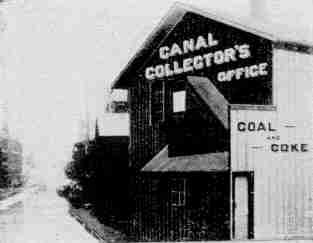
The Toll Collector's Office located at the Third Street canal bridge.
His salary was $800 a year but he had to spend $300 for office rent and incidentals. He was on duty twenty-four hours a day because boats came through at all times. Mr. Patterson had a small room overlooking the canal. He slept in this room and occupied it all the time, including Sundays and holidays, except when the canal was frozen over. Passing boatmen would get him out at all hours of the night. After a few months, he realized that his net yearly income of $500 was inadequate so he decided to go into the coal business on the side. He hung up a sign proclaiming "Coal and Wood" outside his office. When he received an order he bought coal from a dealer and hired someone to deliver it This left him a very small profit. His day book was a slate. When an account was settled he wiped it off. In this crude way the future magnate of the cash register began his commercial career.
Patterson had big ideas even when he had a little business. He heard that a coal dealer located nearby wanted to sell out. He borrowed $250 from Gebhart, Harman & Co. a local bank and bought the business. The assets were a tumble-down coal yard, a pair of scales, two carts, some coal, lime, cement and wood, and two blind horses. John took his brother Stephen into partner-ship and opened up shop as H. J. Patterson & Co. After he started in the business, he found the best coal to be had, and secured the exclusive agency for it. He built up the business on selling quality coal and giving receipts.
He took his brother, Stephen J. Patterson, into partnership. They employed a clerk, and soon developed a good business. In 1876, Mr. Patterson resigned from the position as toll collector and devoted his entire time to the coal business. From the start John H. was meticulous in his dealings with customers. He needed no Marguery of Paris to tell him that "the customer is always right." He sold the best coal, used spirited horses to draw his brightly painted carts, and advertised liberally. In that early day he revealed the basis of the sound business procedure upon which a world-wide enterprise was later to be reared.
One detail will illustrate.
Some of Patterson's customers disputed the quantity of coal for which they were charged and the amounts they were required to pay. Since every complaint was a personal matter Patterson devised a system of receipt tickets for both coal and cash. It was John H. Patterson who, in later years, first put the receipt on a cash register

J.H.Patterson's Receipt of 1881
Patterson's determination to create good will as well as good business led him into unconventional procedure. He had obtained the agency for Jackson County coal. It was good coal but sometimes it had to be coaxed before it caught fire. It followed that on occasion Patterson had complaints about it
At the root of his business creed was education which always meant training. He later applied it to every detail of his cash register production and selling. In that early day he demonstrated it with his customers. Although co-head of the coal firm he visited customers' homes, went into kitchens

and showed cooks and housewives how to get the fire started. There were no caste lines in his teaching code. He went from the residences of the socially elect to tenements. Often he would turn up in a kitchen almost before the household was astir. The business increased and they later had two offices in the city. John H. Patterson’s scrupulous attention to details and his liberal expenditures for advertising irked Stephen who, being older, believed in more conservative methods. In consequence, the partner-ship was dissolved in 1879, Stephen buying out John's interest.
A Patterson & Co Receipt of 1883.
With his youngest brother Frank J., John now organized the new coal firm of Patterson & Company. The first period of expansion in John's business life began. Although handicapped by lack of capital John began to widen the firm's activities. The coal they sold came from the Coalton and Weliston fields by a roundabout way which increased the freight over-head.
John H. started a movement which led to the building of a direct line-the Dayton & South eastern-from the mines to Dayton. The Patterson brothers now decided to mine their own coal so they leased mines at Coalton and Wellston. John H. borrowed $15,000 and had 52 coal cars built for the firm's use. They bore the inscription "Patterson & Co." in large vivid letters. John H. always believed in business publicity. The firm flourished.

The Patterson General Store at Coalton, Ohio.
By this time John H. and Frank were operating three coal mines, a chain of retail yards, and a general store at Coalton, Ohio. This same year the narrow gauge railway from Jackson County to Dayton was completed, and the brothers secured the agency for Jackson County coal. While operating the store at Coalton John H. Patterson had his first actual contact with the cash register. He had practically no competition, no bad debts, paid cash for all he bought, and did a big business, that is big, for the locality. At the end of two years he had lost $3,000.
He suffered from the same malady that had played havoc with James Ritty's profits. His clerks, with an open cash drawer constantly conjuring up temptation, purloined part of the daily receipts. One day he heard of a Dayton-made machine that registered sales. Without inquiring the price he telegraphed for three of them. They were the original paper roll machines. Within six months the store showed a profit of several thousand dollars.
The cash registers had turned the trick for there was no more pilfering. Patterson was so impressed with the results that he ordered two registers for his retail coal business in Dayton, and one of these made it possible for the brothers to discover a leak which had been costing them $600 a year for two years. In 1881 John H. Patterson embarked for the first and only time in his life in a business that he did not control. A group of Boston capitalists tied up a network of narrow gauge railroads in Ohio and Indiana, including the Dayton and South Eastern, into a single system. Then they decided to go into the coal business. John H. and Frank Patterson had become known as the most alert and progressive operators in the Jackson County field.
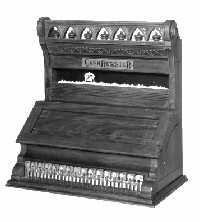
The eastern financiers engaged them to acquire coal mines which were sold to a corporation, The Southern Ohio Coal and Iron Company, which they formed to operate the properties. The Pattersons took over the management of the mines and the sale of the product receiving an allocation of stock and bonds for their services.
By 1882 Patterson & Co. had six offices; Office A, at Third Street opposite the Park; Office B,near T. D. & D.& B. ( Toledo,Delphos, Dayton & Burlington) Railroad Depot; Office C, Third Street, near Railroad Crossing; Office D, Wayne Street opposite market House; Office E, at Southern Ohio Coal & Iron Co's Transfer; Office F, at Fifth Street Railroad Crossing.
They continued their retail coal business in Dayton, after selling their own mines and leasing their equipment to the corporation. John H. Patterson was made the manager of the Southern Ohio Coal and Iron Company. The association with the Southern Ohio Coal and Iron Company was not altogether happy. John H. Patterson was a minority stockholder. Being wilful and impatient, he chafed under the restraint that this imposed. He was born to control and he had no control over the properties he managed. Frank, who was much less temperamental, took things in his stride. John H's dissatisfaction with the situation led to two events. One was the retirement of the brothers from association with The Southern Ohio Coal and Iron Company. The other was the sale of their coal business in Dayton. For the first time since he established himself in the little toll-keeper's office on the Miami and Erie Canal John was free to do as he pleased.
A year prior to their retirement from all branches of the coal business John H. and Frank had made their initial investment in The National Manufacturing Company which in 1883,decided to increase the capital stock from $12,000 to $l5,000 and John H. Patterson, Frank J. Patterson, and Stephen J. Patterson bought all of the new stock issued.with the purchase of 50 shares.
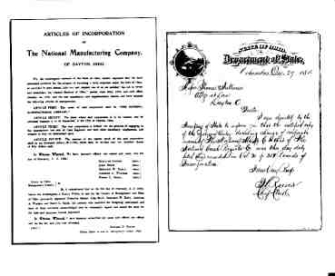
John H. was the instigator because he had a strong conviction, based on his experience with cash registers both at Coalton and Dayton, that the machine had a future. The cash register business, however, was not getting anywhere. The annual statement of the company, issued early in 1884, showed a loss. This discouraged Frank to such an extent that he disposed of all of his shares. John H. could only get rid of five. This explains how it happened that he appeared on the books of the company as owner of 20 shares at the annual meeting held in January 1884.
His retirement as a director followed.
It was impossible for a man of John H. Patterson's temperament to remain idle. As he cast about for an activity to engage his energy his thoughts reverted to those rigorous boyhood days on the Rubicon Farm. He was torn between farming and manufacturing. For the moment some occupation on the land seemed to win out In his impulsive way he said to Frank: "We should get into a business with limitless possibilities. Nearly everybody eats meat. Let us buy a ranch and raise cattle." When Patterson spoke of "limitless possibilities" he revealed the extent of the vision that was to lead him to the industrial heights. Always impatient of petty details, he saw life and work in a large way. Frank was agreeable to the cattle-raising suggestion. In May 1884 the brothers set forth for the West which still beckoned to the seeker of business and other adventure. For four months they ranged through half a dozen States from Missouri to California. Late in September they paused at the Antlers Hotel in Colorado Springs to take stock of travels, and to decide which one of three ranches, on which they had options, to buy.
This photograph was taken in Montana during the six month trip to find a ranch.
John H Patterson is on the right and his brother Frank on the left
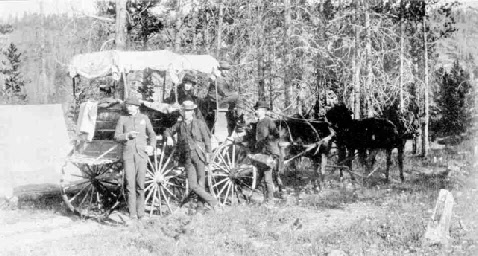
On the evening of the day the Pattersons arrived in Dayton-it was now late in October-they had a long talk with George L. Phillips, President of The National Manufacturing Company, who owned the controlling interest. Phillips was a well-known Dayton capitalist who organized the first telephone exchange in the city. John H. agreed to buy the Phillips stock for $6500. After the deal had been closed, save for the actual payment, the brothers went over to the Dayton Club where they spoke enthusiastically about the transaction. What they did not know was that The National Manufacturing Company had become something of a jest in town. It had lost money steadily and was looked upon as a failure.
It followed that when the Pattersons spoke so glowingly about their purchase of control they were met with jokes and even jeers. The banter at the club depressed and discouraged John H. He went home that night determined to cancel the deal with Phillips the first thing next morning. Just why he got cold feet on the product to which he subsequently dedicated himself is inexplicable. John H. Patterson, however, was a capricious person. It was difficult at times to understand what motivated certain of his actions.
When Patterson sought to retire from the deal he was thwarted. Phillips insisted that the strict letter of the arrangement be carried out. Patterson then offered him $2,000 for a release from his obligation. Phillips remained adamant. To Patterson he is reported to have said
"You have purchased the stock. If you had paid for it and I had turned it over to you, I. would not have it back as a gift."
"Very well," replied Patterson. "I am going into the cash register business and I will make a success of it. You will be sorry later on."
Every outstanding industry sets up mile-posts of its progress. So it was with cash register production which flow entered upon the first phase of what became a momentous advance. The time had arrived when the chief protagonist in the drama of its development stepped on the scene. That protagonist was John H. Patterson.
Soon after he acquired control Patterson changed the corporate name of the company back to that of The National Cash Register Company. The hesitancy in the deal with Phillips was obviously a passing phase with Patterson. Once committed to the cash register it became the passion of his life, charged with the fire and fervour of a crusade.
Every outstanding industry sets up mile-posts of its progress. So it was with cash register production which flow entered upon the first phase of what became a momentous advance. The time had arrived when the chief protagonist in the drama of its development stepped on the scene. That protagonist was John H. Patterson.
Soon after he acquired control Patterson changed the corporate name of the company back to that of The National Cash Register Company. The hesitancy in the deal with Phillips was obviously a passing phase with Patterson. Once committed to the cash register it became the passion of his life, charged with the fire and fervour of a crusade.
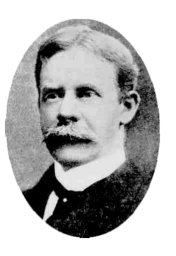

John Henry Patterson 1844-1922
The Biography of the Founder of NCR
Part 2. 1885-1922
1885
At the stock-holders' meeting held on January 5, 1885 John H. Patterson was revealed as the owner of 227 shares out of a total of 300. Frank Patterson had one share. The following year the capital stock was increased to $100,000, divided into 2,000 shares of $50 par value each.
Meanwhile John H. had acquired the shares of Charles Whelan and William Sander, the only other stockholders, thus establishing complete Patterson control of the business. It was to remain a family affair until after the death of John H. Patterson in 1922.
Thirteen Men on First N.C.R. Payroll
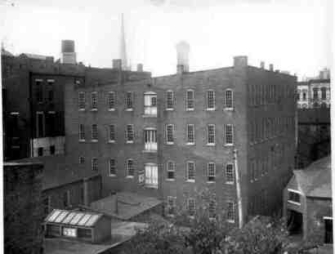
The company at that time employed thirteen men, and occupied space in the Callahan Power Building, which was located in an alley between Second and Third Streets, east of Main. In December, 1884, the name was changed to The National Cash Register Company.
Callahan Power Building
The selling force of the new company consisted of one active sales agent and a number of agents in the person of grocers, or business people engaged in some other line of work.
Business Prospers Under His Direction
Under the direction of Mr. Patterson the organization began to prosper, and more sales agents were appointed, and improved registers were made. The Company began to acquire additional rooms in the Callahan Power Building, and soon had reached the limit of expansion in those quarters.
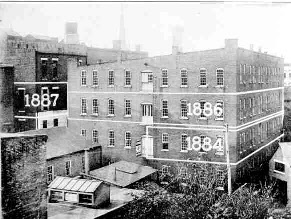
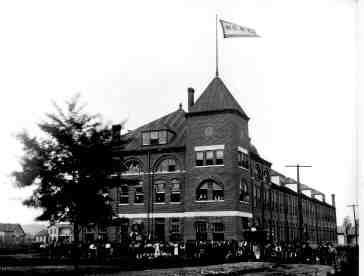
The First Purpose Built Factory
Mr. Patterson now decided to build a factory. He chose as his location the old farm, and in 1888 the first factory building was completed on ground which when a boy he had ploughed.This factory was far from measuring up to the model factory of today, but it compared favorably with other factories of that period. In 1888, he was married to Katherine Dudley Beck, of Brookline, Mass., a young lady of charming personality and a member of an old New England family.
the model factory of today, but it compared favorably with other factories of that period. In 1888, he was married to Katherine Dudley Beck, of Brookline, Mass., a young lady of charming personality and a member of an old New England family.
Shortly after their marriage the home of Robert Steele, at First and Ludlow Streets, was purchased. This home is now known as the N C R City Club. Two children came to brighten the home, Frederick Beck, born June 22, 1892, and Dorothy Forster, born October 27, 1893. Following a brief but acute illness, death claimed Mrs. Patterson in June, 1894. Those who knew Mrs. Patterson intimately spoke of her as a woman of unusual strength of character, high ideals, and gifted with the finest qualities of head and heart. Her untimely death robbed her husband and babes of the rarest ministry in life, the sacrificial love of a noble and gentle wife and mother.
Mrs Dorothy Paterson and her two children, Dorothy Forster and Frederick Beck Patterson.
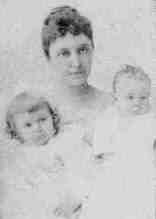
Faith in Register Remains Unshaken
In 1894, $50,000 worth of registers were returned as defective, which endangered the success of the Company. Mr. Patterson knew that the design of the machine was right and that something must be wrong in the factory. He moved his desk from the executive offices into the heart of the factory and began a thorough investigation.
He found many things wrong, and to remedy them he began what is now known all over the world as industrial welfare work.
What Mr. Patterson Found
He found that workmen were trying to make the new model machines with the same tools with which they had made the earlier models. The factory, like most factories at that time, was unsanitary. The grounds were littered with scrap and material and surrounded by a high board fence.
He began with the improvement of working conditions. Better sanitary accommodations were furnished, and the high board fence removed. The next spring shrubbery was planted and grass seed sown. The result of this welfare work was immediately apparent in better work on the part of all the employees. This proved to Mr. Patterson that he was pursuing the proper course.
He one day noticed one of the women employees trying to warm a pail of coffee on a steam radiator at luncheon time. This he said started him thinking of the benefit of a hot noon meal for factory workers. First, the girls were given a hot lunch at cost of food and the system was gradually enlarged to include all employees.
The luncheon system was part of the health promotion activities of the factory. Rest periods for the women twice daily were introduced. and the benefit to all of outdoor exercise was taught in every possible way.
He was Severely Criticized
He was unmercifully criticized and ridiculed. But in the face of all adverse criticism he persisted. and the effect was soon apparent.
Having improved conditions in the factory he began to help the neighborhood. This work started among the children. One of the big problems was what to do with the boys of Slidertown. They broke the windows in the factory and destroyed the shrubbery and flowers.
The Boy Garden Movement
Mr. Patterson felt that these boys were not really bad boys, but just average children with nothing useful to do. He obtained a small house near the factory and engaged the services of a noted settlement worker, Miss Harvey. The boys were invited to a meeting. They were given an opportunity to learn clay modelling, wood carving, and drawing. Then he gave the girls something to do, and classes in sewing, embroidery, and cooking were started.
Remembering the many valuable lessons he had learned on the farm, Mr. Patterson had a piece of ground cleared near the factory, purchased the necessary tools, and gave each boy a garden to take care of. Seeds and a competent instructor were provided and the vegetables raised belonged to the boys.
This was the beginning of the children's garden movement in America. Today practically every community has its children's gardens. In Dayton almost all of the schools include a course of gardening.
Prizes were offered to the residents of the neighborhood for the best kept lawns, back yards, and gardens. A campaign of improvement was started which resulted in the transformation of Slidertown into South Park, one of the desirable residential sections of the city.
Example Set by Mr. Patterson
The work carried on about the factory was so noticeable that it affected other parts of the city, and before long Dayton became known far and wide for its beautiful home surroundings. This type of community welfare work was taught by Mr. Patterson through illustrated lectures given in all sections of the country continuously since 1898.
July 4, 1901, his brother, Frank J. Patterson, who, for twenty-two years had been his partner, died. His untimely death, in the very prime of life, left the entire burden of the business upon the shoulders of John H. Patterson.
The foreign business of the Company required a great deal of Mr. Patterson's attention and he spent much time abroad. During his life he travelled around the world and made many trips to Europe and other countries. His business cares both at home and abroad resulted in a serious breakdown in 1904.
Following a fast of thirty-seven days and a prolonged rest in Europe, Mr. Patterson regained his vigor of body. He made a study of the best rules of health, lived up to them strictly, and until his death effectively promoted health education in industry, school community, and the nation.
The Dayton Flood
During the great flood of 1913, John H. Patterson rendered splendid service to the stricken community. It has often been said that had it not been for his masterful leadership, unusual organizing ability, and remarkable forethought there would have been much more suffering and a far greater loss of life.
Before the flood waters of the river broke through the levees March 25, 1913, Patterson began to prepare to meet the terrible catastrophe. Looking out over the swollen river, from his office window, at 6:30 in the morning - his usual time of arrival - he said:
"Dayton will have an awful flood today. We must prepare to house and feed the people who will be driven from their homes."
He at once sent for the Commissary supervisor and asked him about his supplies of food, ordered the Purchasing Office to buy at once all they could secure, sent couriers out over the country to buy more food and send it in, ordered boats made and delivered at various points in the city where they could be used to rescue the people, and by noon of that day had changed the factory into a refuge for the stricken flood sufferers of the city.
N. C. R. Became Home for Refugees
The factory became a home for refugees, a hotel, a hospital, a food supply station, the city hall, the telegraph and telephone center, the post office, the newspaper plant, a drug supply house, and as Arthur Ruhl said in his article in The Outlook, "the stricken city's brains, nerves, almost its food and drink."
After effecting a complete relief organization at the N. C. R. factory, Mr. Patterson during that first forenoon worked at one of the most dangerous points saving men, women, and children.
He directed the relief work, made himself responsible financially for the relief material shipped into Dayton, and gave every one aid who applied for it.
When the United States government officials reached the city while the flood was still on the streets they paid a great tribute to him when they said:
"We can do nothing more than you have already done."
Mr. Patterson was appointed chairman of a Citizens' Relief Committee consisting of five men: Colonel John H. Patterson, Colonel Frank T. Huffman, Alan Edward, O. Phillips, Adam Schantz, John R. Flotron. As chairman he was commissioned by the governor with 'full authority'," to act for and on behalf of the Citizens' Relief Committee to take entire charge of the relief work for the present and future up-building of the city."
Protection Against a Future Flood
Immediately following the flood, Mr. Patterson called a meeting of the leading citizens of Dayton in the Schoolhouse of The National Cash Register Company. He proposed an organization for the purpose of providing against the recurrence of a flood. "We need protection," he declared. "We must raise an ample fund to provide the cost of surveys, education, and legislation."
Two million dollars were raised by popular subscription, to which fund Mr. Patterson contributed most generously. Prominent engineers from all parts of the world were brought to Dayton to study the question of flood protection, and a comprehensive plan was adopted. The Miami Conservancy District was formed, special legislation finally secured through the state assembly, and work was begun on the greatest engineering project, next to the Panama Canal, the world had ever seen. The work was finished by the early 1920's, and Dayton has no fear of floods.
A Model City Government
In 1896, when Dayton was celebrating its first centennial, Mr. Patterson, the chief speaker, outlined what Dayton should do to become a model city. He kept the ideal before the people year by year until finally the present commission-manager form of charter government was adopted.
In the early summer of 1912 he sent a representative of Dayton to Europe to study municipalities their government and welfare work in city and industry. In September 1912 a report of this study was made to Dayton citizens.
Under Mr. Patterson's direction a vigorous campaign of education for better government was immediately started and an organization effected and largely financed by him through which in less than one year the present model city charter was adopted.
It is significant that Mr Patterson began this vigorous campaign for a new type of city government in September 1912 the exact date when the new constitution of the state became effective and by providing for "Home Rule for cities made possible the radical change in the charter of the city.
War First and Business Second
At the outbreak of the great war The National Cash Register Company refused to take on war orders so long as the United States was not involved. But when the United States declared war in 1917, President John H. Patterson sent a personal representative to Washington to place his entire factory at the disposal of the government.
Because of its reputation for work requiring precision, the Company was given contracts to produce parts which required the highest type of skilled workmen. Work was at once offered by the government and accepted and finished in record time.
Mr. Patterson coined and placed in every department of the factor,' the slogan, "War First, Business Second, if there is any time for business."
Wanted Only What He Had Earned
He refused to accept contracts on a strictly cost plus basis. He said it was not right to do work for the government on a basis where the more he spent the more he made, because the taxpayers of the nation had to hear the burden.
Following the signing of the armistice, Mr. Patterson was one of the first prominent American business men to go to Europe to study conditions with a view of improving business.
Believed in Travel for Education
His frequent trips to Europe were part of his system of self-education. He usually had some definite subject which he wished to investigate factory welfare work, the landscape gardening methods of the Old World, and on his last trip the Association of Nations for World Peace.
Travel and attendance at conventions were two forms of education which Mr. Patterson urged upon the men and women with whom he worked. His generosity in providing for this sort of study is well known.
Taught How to Sell His Product
The making, recording, and selling divisions of the National Cash Register business were brought together by Mr. Patterson in an effective way. He constantly brought factory men into the sales and advertising councils and insisted that the factory workers should familiarize themselves with the selling problems of the Company."
On Company time" was a phrase he constantly used. He insisted that it was profitable to the Company for the different persons of the organization to become acquainted with each other's problems.
Years would often pass before his motives in holding certain meetings and conferences would begin to dawn on some of those who had been present. In the meantime, however, the information acquired had been applied for the general good of the industry.
Passed Good Ideas Along
Mr. Patterson's method was to carry every good idea as far as it could be made to go. He was anxious to pass ideas on to others. Factory employees, workers in different welfare and civic organizations, teachers, ministers, and persons of many other groups were among those whom he sent on these educational trips.
Mr. Patterson addressed many conventions and conferences in regard to methods of improving the conditions under which manufacturing is done. He trained men and women to lecture on these and other subjects. They with their stereopticon slides and motion picture films lectured in every state in the nation and in other countries
Many summers spent in the Adirondick Mountains had proved to Mr. Patterson's own satisfaction that renewed health could be gained in the woods. The many open camps in Hills and Dales where first his employees and later all citizens of Dayton could go for a day's outing, were an outcome of this experience.
Gives About twenty years previous to the time when he gave over three hundred acres of his Hills and Dales estate to the city of Dayton. Mr. Patterson had been one of a group of Oakwood people who had offered a much smaller but very beautiful piece of ground in that region to the city council. The gift was refused. and he then began to educate the public to appreciate the need of parks. When the second offer was made in 1918, Daytonians accepted it with enthusiasm.
Teaching Through the Eye
For convenience in handling a subject thoroughly, Patterson perfected, some years ago, a "bulletin" system. On sheets of white paper he would draw rapidly a graphic outline of the different phases of the subject to be studied or discussed. Subdivisions would be properly arranged and he would draw for each person working with him all that he or she could contribute, putting each suggestion or fact in its proper place.
Whenever possible, he would assemble his ideas on a subject in fives. and there came to be a standard bulletin form. At some conferences page after page of the big white paper sheets would be covered with drawn and written diagrams in colored crayon. These were kept for reference, and were often printed for general distribution.
Sometimes the meeting consisted of salesmen of cash registers from all over the world; or a little group of neighborhood improvement workers; or a convention of a state or national organization which Mr. Patterson had been asked to address.
Saturday Meetings for the Children
A most important public service provided by Mr. Patterson was the regular Saturday morning entertainment for school children at the N C R Schoolhouse and the N C R Auditorium on North Ludlow Street. Onlv the best moving pictures are used. There are pageants, playlets, and singing by the children, and talks on health, thrift, patriotism, and other subjects.
The treat of fruit and cakes that invariably ends the meetings shows the attention to detail and the knowledge of human nature that were at the root of John H. Patterson's success in so many wider fields.
He always insisted upon the practice of religious principles. He aided many religious organizations besides the Protestant Episcopal Church, of which he was a lifelong member. He had an abiding faith in the effective leadership of the church.
He was a vestryman of Christ Episcopal Church in former years, and also superintendent of St. Andrew's Sunday School.
His Far Hills Home
The home in which Mr. Patterson lived, set like a Swiss chalet among beautiful hills, and unpretentious in architecture, was planned for use and not for display. Mr. Patterson was always an ideal host. He was never happier than when entertaining groups of men and women whom he had invited to a dinner discussion of some business, civic, educational, or philanthropic project. Many years ago he opened his beautiful and spacious grounds to the public and placed entrance signs bidding every one welcome. He laid out a six-link golf course on his front lawn, and invited the public to use it.
He was often called to counsel with the business leaders of the world in regard to world-wide problems, and his opinion was sought by men in all walks of life.
Mr. Patterson received many honors during his life. In 1901, he was made a chevalier of the Legion of Honor by the French government in recognition of what he had done toward improving the condition of the employees in the factory and the people of the neighborhood, and the widening circle of good which had radiated therefrom to other manufacturing institutions all over the country.
In 1913, he was awarded the Dr. Louis Livingstone Seaman gold medal for progress and achievement in industrial hygiene and safety by the American Museum of Safety.
In 1920, he was made Doctor of Laws by the Miami University at Oxford. President Hughes, of Miami University, when conferring the degree of Doctor of Laws on Mr. Patterson, said:
"Upon you, John Henry Patterson, business executive, public spirited citizen, leader of men, in recognition of your farsighted business judgment, of your unusual executive ability, of your great public service to the city of Dayton through the years, especially in the hour of her great distress, of your skill in using the best methods of teaching in every department of a great industry, of your leadership in manufacturing methods, and in dealing with the complex labor problems of today, by vote of the University Senate and with the approval of the Board of Trustees, and authority granted by the State of Ohio. Miami University confers the degree of Doctor of Laws. * * * "
Mr. Patterson's Immediate Family
At the time of his death in 1922 the members of Mr. Patterson's family were his son, Frederick Beck, his daughter, Dorothy Forster Judah, and his sister, Julia P. Crane. Frederick Beck Patterson was the president of The National Cash Register Company, and resided in Oakwood, a suburb of Dayton, with his wife, Evelyn Van Tyne Huffman Patterson, and his baby daughter, Fredericka Beck Patterson.
Mrs. Noble Brandon Judah (Dorothy Patterson) was the wife of a well-known attorney of Chicago, Colonel Noble Brandon Judah.
Mr. Patterson was a man of rare vision. He could see farther into the future than others, and hence was often misunderstood, criticized, and opposed.
He was a generation in advance of the times. He was both an idealist and an administrator. He could dream and he could organize to make the dream come true; not often in a generation is there found this rare combination the power to see and the power to build. He left unfinished tasks, his dreams not fully realized, a program of work not yet completed. This is the sacred trust now committed to us.





